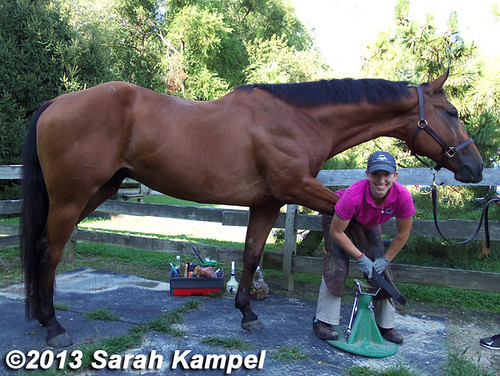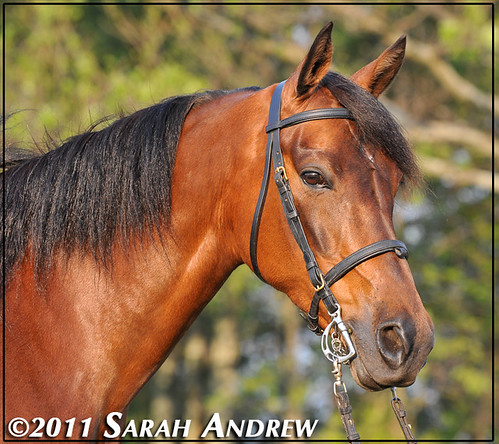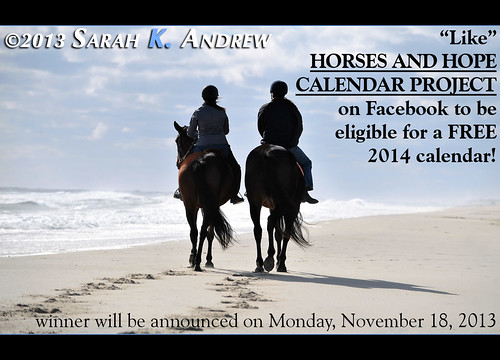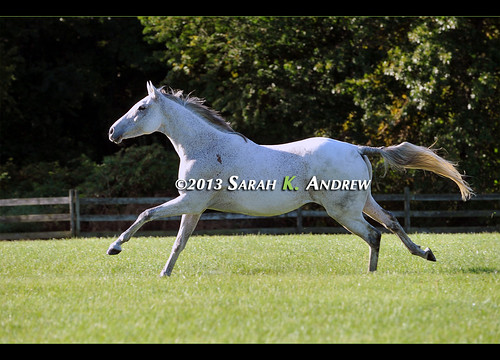You might think, "A new calendar, just like my old one, right? Kittens last year, Vincent van Gogh the year before, Dilbert the year before, and they are all calendars."
The Horses and Hope calendar is not your everyday, run-of-the-mill calendar. Here's why:
1) 100% of the calendar proceeds are donated to help horses in need. Gina Keesling and I put this calendar together as volunteers, and we give back every cent of the profit to help our equine community. In 2013 and 2013, this calendar raised over $80,000 in donations and helped over 800 horses through the good work of One Horse at a Time, a 501(c)(3) organization. This calendar fed hungry horses, this calendar gelded hundreds of colts, and this calendar helped horses get emergency medical care.
2) It's BIG and the paper is THICK. These calendars are 12" square, opening up to a 12" x 24" display. If you think the photos look nice on your computer screen, you'll love how they look in living color. The paper is great for all those notes you make about meetings, birthdays, and farrier appointments.
3) You get your money's worth. Most calendars give you 12 months and 12 photos. Through the excellent calendar designs of Gina Keesling, you'll see photos of over 100 horses in every Horses and Hope calendar.
4) The photos are special. I'm not saying this because I took them, but because they are photos of some exceptional horses. These horses have stories to tell, and once you know their stories, you'll never forget their faces. People all over the world have bought this calendar, to enjoy the photos and to be a part of our fundraising project.
5) Speaking of stories, we tell the stories of these horses in the calendar. Our calendar models are not the nameless pretty faces in typical store-bought horse calendars. Gina and I interviewed the owners and put together memorabilia and before/after photos to give you an idea of the work and care that goes into a rescue/rehab project.
6) Since you're a horse lover, you'll be happy to know that the calendar contains birthdays of famous horses, interesting trivia about special days in history, unique horse-related holidays, moon phases for your moonlit rides, and Daylight Savings notes so you know what day you will be able to do trail rides after work again.
7) Each month, you'll get your share of equine eye candy. Our calendar celebrates dozens of breeds of horses, and showcases every equine color imaginable, with a rainbow of Appaloosas, pintos, palominos, and so much more.
8) You'll get to know some of the fan favorites, like Jefferson Airplane the donkey, Rosebud the mule, and Tristan the Belgian, and we'll share updates and let you know how they're doing.
9) The calendar is a valuable teaching tool. Teachers use it in their classrooms, and calendar readers can learn about the versatility of the Standardbred, the work that the Retired Racehorse Training Project does, and how a little patience can turn a horse like Chance into a really fun riding horse.
10) The Horses and Hope calendar tells inspirational and positive stories of hope. Some of these horses in the calendars faced uncertain futures and were in bad situations, but they found good homes and excellent care through the efforts of some very dedicated people. Isn't that a great thing to see when you look at your calendar for the next 365 days?
With the help of
Gina Keesling of HoofPrints, the 2012 and 2013 Horses and Hope calendars
featured stories and photos of hundreds of horses. Thanks to the
support of horse lovers everywhere, it raised thousands of dollars for One Horse At A
Time, helping hundreds of horses in need directly, and untold others
indirectly through increased public awareness. Now that we have two calendars'
worth of experience to draw upon, the 2014 version promises to be even more
exciting, even more creative, and as always, inspirational and positive.
Have you read the GREAT PRESS we've received recently?
Fran Jurga's writeup for Equisearch/EQUUS (click here)
Nancy Jaffer's article in the Sunday Star-Ledger (click here)
Have you read the GREAT PRESS we've received recently?
Fran Jurga's writeup for Equisearch/EQUUS (click here)
Nancy Jaffer's article in the Sunday Star-Ledger (click here)














































